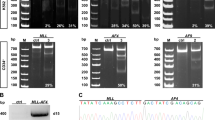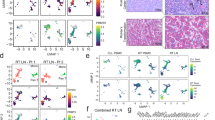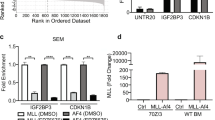Abstract
The hematological malignancies classified as mixed lineage leukemias (MLL) harbor fusions of the MLL1 gene to partners that are members of transcriptional elongation complexes. MLL-rearranged leukemias are associated with extremely poor prognosis, and response to conventional therapies and efforts to identify molecular targets are urgently needed. Using mouse models of MLL-rearranged acute myeloid leukemia, here we show that genetic inactivation or small-molecule inhibition of the protein arginine methyltransferase PRMT5 exhibit anti-tumoral activity in MLL-fusion protein-driven transformation. Genome-wide transcriptional analysis revealed that inhibition of PRMT5 methyltransferase activity overrides the differentiation block in leukemia cells without affecting the expression of MLL-fusion direct oncogenic targets. Furthermore, we find that this differentiation block is mediated by transcriptional silencing of the cyclin-dependent kinase inhibitor p21 (CDKN1a) gene in leukemia cells. Our study provides pre-clinical rationale for targeting PRMT5 using small-molecule inhibitors in the treatment of leukemias harboring MLL rearrangements.
This is a preview of subscription content, access via your institution
Access options
Subscribe to this journal
Receive 12 print issues and online access
$259.00 per year
only $21.58 per issue
Buy this article
- Purchase on Springer Link
- Instant access to full article PDF
Prices may be subject to local taxes which are calculated during checkout







Similar content being viewed by others
References
Krivtsov AV, Armstrong SA . MLL translocations, histone modifications and leukaemia stem-cell development. Nat Rev Cancer 2007; 7: 823–833.
Somervaille TC, Cleary ML . Grist for the MLL: how do MLL oncogenic fusion proteins generate leukemia stem cells? Int J Hematol 2010; 91: 735–741.
Jude CD, Climer L, Xu D, Artinger E, Fisher JK, Ernst P . Unique and independent roles for MLL in adult hematopoietic stem cells and progenitors. Cell Stem Cell 2007; 1: 324–337.
Bernt KM, Armstrong SA . Targeting epigenetic programs in MLL-rearranged leukemias. Hematology Am Soc Hematol Educ Program 2011; 2011: 354–360.
Santos MA, Faryabi RB, Ergen AV, Day AM, Malhowski A, Canela A et al. DNA-damage-induced differentiation of leukaemic cells as an anti-cancer barrier. Nature 2014; 514: 107–111.
Bedford MT, Richard S . Arginine methylation an emerging regulator of protein function. Mol Cell 2005; 18: 263–272.
Pal S, Vishwanath SN, Erdjument-Bromage H, Tempst P, Sif S . Human SWI/SNF-associated PRMT5 methylates histone H3 arginine 8 and negatively regulates expression of ST7 and NM23 tumor suppressor genes. Mol Cell Biol 2004; 24: 9630–9645.
Zhao Q, Rank G, Tan YT, Li H, Moritz RL, Simpson RJ et al. PRMT5-mediated methylation of histone H4R3 recruits DNMT3A, coupling histone and DNA methylation in gene silencing. Nat Struct Mol Biol 2009; 16: 304–311.
Chen H, Lorton B, Gupta V, Shechter D . A TGFbeta-PRMT5-MEP50 axis regulates cancer cell invasion through histone H3 and H4 arginine methylation coupled transcriptional activation and repression. Oncogene 2016; 36: 373–386.
Pal S, Baiocchi RA, Byrd JC, Grever MR, Jacob ST, Sif S . Low levels of miR-92b/96 induce PRMT5 translation and H3R8/H4R3 methylation in mantle cell lymphoma. EMBO J 2007; 26: 3558–3569.
Aggarwal P, Vaites LP, Kim JK, Mellert H, Gurung B, Nakagawa H et al. Nuclear cyclin D1/CDK4 kinase regulates CUL4 expression and triggers neoplastic growth via activation of the PRMT5 methyltransferase. Cancer Cell 2010; 18: 329–340.
Kirino Y, Kim N, de Planell-Saguer M, Khandros E, Chiorean S, Klein PS et al. Arginine methylation of Piwi proteins catalysed by dPRMT5 is required for Ago3 and Aub stability. Nat Cell Biol 2009; 11: 652–658.
Vagin VV, Wohlschlegel J, Qu J, Jonsson Z, Huang X, Chuma S et al. Proteomic analysis of murine Piwi proteins reveals a role for arginine methylation in specifying interaction with Tudor family members. Genes Dev 2009; 23: 1749–1762.
Wei H, Wang B, Miyagi M, She Y, Gopalan B, Huang DB et al. PRMT5 dimethylates R30 of the p65 subunit to activate NF-kappaB. Proc Natl Acad Sci USA 2013; 110: 13516–13521.
Hsu JM, Chen CT, Chou CK, Kuo HP, Li LY, Lin CY et al. Crosstalk between Arg 1175 methylation and Tyr 1173 phosphorylation negatively modulates EGFR-mediated ERK activation. Nat Cell Biol 2011; 13: 174–181.
Zheng S, Moehlenbrink J, Lu YC, Zalmas LP, Sagum CA, Carr S et al. Arginine methylation-dependent reader-writer interplay governs growth control by E2F-1. Mol Cell 2013; 52: 37–51.
Jansson M, Durant ST, Cho EC, Sheahan S, Edelmann M, Kessler B et al. Arginine methylation regulates the p53 response. Nat Cell Biol 2008; 10: 1431–1439.
Wang L, Pal S, Sif S . Protein arginine methyltransferase 5 suppresses the transcription of the RB family of tumor suppressors in leukemia and lymphoma cells. Mol Cell Biol 2008; 28: 6262–6277.
Chung J, Karkhanis V, Tae S, Yan F, Smith P, Ayers LW et al. Protein arginine methyltransferase 5 (PRMT5) inhibition induces lymphoma cell death through reactivation of the retinoblastoma tumor suppressor pathway and polycomb repressor complex 2 (PRC2) silencing. J Biol Chem 2013; 288: 35534–35547.
Li Y, Chitnis N, Nakagawa H, Kita Y, Natsugoe S, Yang Y et al. PRMT5 is required for lymphomagenesis triggered by multiple oncogenic drivers. Cancer Discov 2015; 5: 288–303.
Chan-Penebre E, Kuplast KG, Majer CR, Boriack-Sjodin PA, Wigle TJ, Johnston LD et al. A selective inhibitor of PRMT5 with in vivoand in vitro potency in MCL models. Nat Chem Biol 2015; 11: 432–437.
Jin Y, Zhou J, Xu F, Jin B, Cui L, Wang Y et al. Targeting methyltransferase PRMT5 eliminates leukemia stem cells in chronic myelogenous leukemia. J Clin Invest 2016; 126: 3961–3980.
Liu F, Cheng G, Hamard PJ, Greenblatt S, Wang L, Man N et al. Arginine methyltransferase PRMT5 is essential for sustaining normal adult hematopoiesis. J Clin Invest 2015; 125: 3532–3544.
Kim D, Pertea G, Trapnell C, Pimentel H, Kelley R, Salzberg SL . TopHat2: accurate alignment of transcriptomes in the presence of insertions, deletions and gene fusions. Genome Biol 2013; 14: R36.
Anders S, Pyl PT, Huber W . HTSeq—a Python framework to work with high-throughput sequencing data. Bioinformatics 2015; 31: 166–169.
Anders S, Huber W . Differential expression analysis for sequence count data. Genome Biol 2010; 11: R106.
Subramanian A, Tamayo P, Mootha VK, Mukherjee S, Ebert BL, Gillette MA et al. Gene set enrichment analysis: a knowledge-based approach for interpreting genome-wide expression profiles. Proc Natl Acad Sci USA 2005; 102: 15545–15550.
Kondo Y, Shen L, Yan PS, Huang TH, Issa JP . Chromatin immunoprecipitation microarrays for identification of genes silenced by histone H3 lysine9 methylation. Proc Natl Acad Sci USA 2004; 101: 7398–403.
Martens JH, O’Sullivan RJ, Braunschweig U, Opravil S, Radolf M, Steinlein P et al. The profile of repeat associated histone lysine methylation states in the mouse epigenome. EMBO J 2005; 24: 800–812.
Schmittgen TD, Livak KJ . Analyzing real-time PCR data by the comparative C(T) method. Nat Protoc 2008; 3: 1101–1108.
Mukhopadhyay A, Deplancke B, Walhout AJ, Tissenbaum HA . Chromatinimmunoprecipitation (chip) coupled to detection by quantitative realtime PCR to study transcription factor binding to DNA in caenorhabditis elegans. Nat Protoc 2008; 3: 698–709.
Tee WW, Pardo M, Theunissen TW, Yu L, Choudhary JS, Hajkova P et al. Prmt5 is essential for early mouse development and acts in the cytoplasm to maintain ES cell pluripotency. Genes Dev 2010; 24: 2772–2777.
Krivtsov AV, Twomey D, Feng Z, Stubbs MC, Wang Y, Faber J et al. Transformation from committed progenitor to leukaemia stem cell initiated by MLL-AF9. Nature 2006; 442: 818–822.
Neubauer A, Maharry K, Mrozek K, Thiede C, Marcucci G, Paschka P et al. Patients with acute myeloid leukemia and RAS mutations benefit most from postremission high-dose cytarabine: a Cancer and Leukemia Group B study. J Clin Oncol 2008; 26: 4603–4609.
Pardee TS, Zuber J, Lowe SW . Flt3-ITD alters chemotherapy response in vitro and in vivoin a p53-dependent manner. Exp Hematol 2011; 39: 473–85 e4.
Schoch C, Schnittger S, Klaus M, Kern W, Hiddemann W, Haferlach T . AML with 11q23/MLL abnormalities as defined by the WHO classification: incidence, partner chromosomes, FAB subtype, age distribution, and prognostic impact in an unselected series of 1897 cytogenetically analyzed AML cases. Blood 2003; 102: 2395–2402.
Zuber J, Radtke I, Pardee TS, Zhao Z, Rappaport AR, Luo W et al. Mouse models of human AML accurately predict chemotherapy response. Genes Dev 2009; 23: 877–889.
Zuber J, Shi J, Wang E, Rappaport AR, Herrmann H, Sison EA et al. RNAi screen identifies Brd4 as a therapeutic target in acute myeloid leukaemia. Nature 2011; 478: 524–528.
Koh CM, Bezzi M, Low DH, Ang WX, Teo SX, Gay FP et al. MYC regulates the core pre-mRNA splicing machinery as an essential step in lymphomagenesis. Nature 2015; 523: 96–100.
Somervaille TC, Matheny CJ, Spencer GJ, Iwasaki M, Rinn JL, Witten DM et al. Hierarchical maintenance of MLL myeloid leukemia stem cells employs a transcriptional program shared with embryonic rather than adult stem cells. Cell Stem Cell 2009; 4: 129–140.
Bernt KM, Zhu N, Sinha AU, Vempati S, Faber J, Krivtsov AV et al. MLL-rearranged leukemia is dependent on aberrant H3K79 methylation by DOT1L. Cancer Cell 2011; 20: 66–78.
Wong P, Iwasaki M, Somervaille TC, Ficara F, Carico C, Arnold C et al. The miR-17-92 microRNA polycistron regulates MLL leukemia stem cell potential by modulating p21 expression. Cancer Res 2010; 70: 3833–3842.
Zhang T, Gunther S, Looso M, Kunne C, Kruger M, Kim J et al. Prmt5 is a regulator of muscle stem cell expansion in adult mice. Nat Commun 2015; 6: 7140.
Saramaki A, Banwell CM, Campbell MJ, Carlberg C . Regulation of the human p21(waf1/cip1) gene promoter via multiple binding sites for p53 and the vitamin D3 receptor. Nucleic Acids Res 2006; 34: 543–554.
Siatecka M, Lohmann F, Bao S, Bieker JJ . EKLF directly activates the p21WAF1/CIP1 gene by proximal promoter and novel intronic regulatory regions during erythroid differentiation. Mol Cell Biol 2010; 30: 2811–2822.
Andreu-Perez P, Esteve-Puig R, de Torre-Minguela C, Lopez-Fauqued M, Bech-Serra JJ, Tenbaum S et al. Protein arginine methyltransferase 5 regulates ERK1/2 signal transduction amplitude and cell fate through CRAF. Sci Signal 2011; 4: ra58.
Kim S, Gunesdogan U, Zylicz JJ, Hackett JA, Cougot D, Bao S et al. PRMT5 protects genomic integrity during global DNA demethylation in primordial germ cells and preimplantation embryos. Mol Cell 2014; 56: 564–579.
Scoumanne A, Zhang J, Chen X . PRMT5 is required for cell-cycle progression and p53 tumor suppressor function. Nucleic Acids Res 2009; 37: 4965–4976.
Yang Y, Bedford MT . Protein arginine methyltransferases and cancer. Nat Rev Cancer 2013; 13: 37–50.
Shi J, Wang E, Milazzo JP, Wang Z, Kinney JB, Vakoc CR . Discovery of cancer drug targets by CRISPR-Cas9 screening of protein domains. Nat Biotechnol 2015; 33: 661–667.
Cheung N, Chan LC, Thompson A, Cleary ML, So CW . Protein arginine-methyltransferase-dependent oncogenesis. Nat Cell Biol 2007; 9: 1208–1215.
Cheung N, Fung TK, Zeisig BB, Holmes K, Rane JK, Mowen KA et al. Targeting Aberrant Epigenetic Networks Mediated by PRMT1 and KDM4C in Acute Myeloid Leukemia. Cancer Cell 2016; 29: 32–48.
Daigle SR, Olhava EJ, Therkelsen CA, Majer CR, Sneeringer CJ, Song J et al. Selective killing of mixed lineage leukemia cells by a potent small-molecule DOT1L inhibitor. Cancer Cell 2011; 20: 53–65.
Dawson MA, Prinjha RK, Dittmann A, Giotopoulos G, Bantscheff M, Chan WI et al. Inhibition of BET recruitment to chromatin as an effective treatment for MLL-fusion leukaemia. Nature 2011; 478: 529–533.
Grembecka J, He S, Shi A, Purohit T, Muntean AG, Sorenson RJ et al. Menin-MLL inhibitors reverse oncogenic activity of MLL fusion proteins in leukemia. Nat Chem Biol 2012; 8: 277–284.
Harris WJ, Huang X, Lynch JT, Spencer GJ, Hitchin JR, Li Y et al. The histone demethylase KDM1A sustains the oncogenic potential of MLL-AF9 leukemia stem cells. Cancer Cell 2012; 21: 473–487.
Acknowledgements
We thank all members of the MA Santos’s laboratory; we thank Na Man from SD Nimer lab for all the technical help; P Jones for discussions, P Whitney for flow cytometry; C Perez for imaging; P Huskey and all members of the Smithville animal facility for animal care; L Coletta for RNA-seq; and J Zuber for MLL-ENL/NrasG12D cells. RASF-Smithville, Laboratory Animal Genetic Services, RHPI—Pathology and Imaging Services were supported by NIH CA16672; the Science Park NGS core by CPRIT RP120348. This work was supported by an American Cancer Society Institutional Research Grant to FL and a CPRIT Recruitment of First-time Tenure-Track Faculty Award (RR150039), a Sidney Kimmel Foundation—Kimmel Scholar Award (SKF-16–061) and a NCI Cancer Center Support Grant (CCSG) New Faculty Award to MAS.
Author contributions
SK, FL, KV, VG, MTB, SDN and MAS participated in the study design. SK, FL, GG, PD and LN performed mouse breeding, hematopoietic stem cell analysis, transplantation and leukemia experiments, and analyzed data. KV led all the ChIP experiments and analyzed data. KL, YZ and YL performed computational experiments. SK, FL, SDN and MAS wrote the manuscript and all authors reviewed it. MAS supervised the project.
Author information
Authors and Affiliations
Corresponding author
Ethics declarations
Competing interests
The authors declare no conflict of interest.
Additional information
Supplementary Information accompanies this paper on the Leukemia website
Rights and permissions
About this article
Cite this article
Kaushik, S., Liu, F., Veazey, K. et al. Genetic deletion or small-molecule inhibition of the arginine methyltransferase PRMT5 exhibit anti-tumoral activity in mouse models of MLL-rearranged AML. Leukemia 32, 499–509 (2018). https://doi.org/10.1038/leu.2017.206
Received:
Revised:
Accepted:
Published:
Issue Date:
DOI: https://doi.org/10.1038/leu.2017.206
This article is cited by
-
Protein arginine methylation: from enigmatic functions to therapeutic targeting
Nature Reviews Drug Discovery (2021)
-
Genomic deregulation of PRMT5 supports growth and stress tolerance in chronic lymphocytic leukemia
Scientific Reports (2020)
-
CARM1 inhibition reduces histone acetyltransferase activity causing synthetic lethality in CREBBP/EP300-mutated lymphomas
Leukemia (2020)
-
The genomics of acute myeloid leukemia in children
Cancer and Metastasis Reviews (2020)
-
NAA40 contributes to colorectal cancer growth by controlling PRMT5 expression
Cell Death & Disease (2019)



